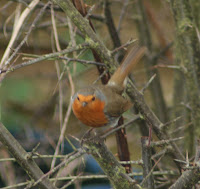Another Early Spring, and Threats of Drought!
I think I am fairly safe in saying it is now officially
springtime. Our clocks reverted to British Summertime on Saturday night.
I’ve just been checking the weather and temperatures
around the country today – Bristol – a cloudless sky since early morning with daytime
temperature - 17ºC [forecast for 4ºC for tonight]; London - 17º - 19ºC
[forecast for 5ºC for tonight]; Newcastle upon Tyne - 19º - 20ºC [forecast for
6ºC for tonight]. It’s interesting that the area which should logically be the
coldest is, in fact, the warmest.
Like last spring, we are having very warm
temperatures with low rainfalls very early in the year. The birds are well on
with nest building and – a reminder to all bird lovers – they do need feeding
and a good source of water at this time of year. I am seeing lots of magpies,
robins, crows, pigeons, tits, sparrows and dunnocks but, unfortunately, very
few blackbirds. I fear the large numbers of magpies around my area have a
significant impact on the numbers of blackbirds.
I have been looking back on my blogs from this time
last year. Certainly then, I was noticing that spring had come early and birds
were already nest-building earlier than this year. However, I didn’t start worrying
about the shortage of water until May. This year there is already a lot of
concern about the low level of water in our reservoirs [mostly due to low
rainfall last year as well as this winter and spring]. Commercial growers are
bracing themselves for a disastrous season. The pond at the bottom of our
allotment fields is already very low and newly hatched tadpoles are becoming stranded
on the fast-drying mudbanks.
 As with all weather conditions – which, let’s face
it, we can’t alter anyway – there are major positives. I have managed to get a
large area of my plot dug over – just a little each day, which will then be
ready for later planted crops such as beans, brassicas and salad crops. I must
still dig patches for sweetcorn, courgettes and some later plantings of other
vegetables.
As with all weather conditions – which, let’s face
it, we can’t alter anyway – there are major positives. I have managed to get a
large area of my plot dug over – just a little each day, which will then be
ready for later planted crops such as beans, brassicas and salad crops. I must
still dig patches for sweetcorn, courgettes and some later plantings of other
vegetables.  Autumn sowings of broad beans now have their flowers on and my spring sown crops are growing on well.
Autumn sowings of broad beans now have their flowers on and my spring sown crops are growing on well.
My first sowing of early peas [Little Marvel -
Dobies] is well up but are still covered with fleece to keep the pigeons off. I
have now sown a second crop [Hurst Green Shaft – Dobies – which were amazingly
successful last year but, my frozen supply is now at an end, unfortunately]. I
have also covered them to keep mice and birds from the seedbeds – this time
with Environmesh.
It is difficult to decide which protective medium is
best. Of course fleece is so much cheaper but, although it can be washed, is
really only useable for one season. It will protect your crops from pests,
birds and frost. However, Environmesh, although so much more expensive, has all
the uses of fleece but, is much more durable. I will expect it to last me for
many years. The cost is definitely a major consideration but, I’ve been
building up my stock by putting it on my Christmas and birthday present lists
for several years. My family is very sensible about buying for presents what is
really wanted. And, my children, who now each have their own allotments, are
more than happy to have essential allotment supplies bought for them on these
occasions.
I have several outdoor seed-beds now which are,
unfortunately, having to be watered on a regular basis – parsley, spring onions,
2 varieties of sorrel, 2 varieties of carrot, coriander and parsnips. So far,
only the spring onions are starting to appear.
In my poly-tunnel, my early potatoes are up,
brassicas in seed beds are showing their second true leaves and a bed of Cos
lettuce [Winter Gem – Vaila] are growing on well. .I have moved young, potted-up
chilli, pepper and tomato plants from my house as they are in desperate need of
better light where, I hope, they will not be attacked by a heavy late frost.
This year, I am planning that my poly-tunnel will be used for crops which I
will use – tomatoes, which I like [no experimental varieties!], chillies
[mostly Joe’s Long, though I’m open to more unusual varieties from my daughter]
and peppers. This space is limited and precious and I have discovered that, in
my area, these crops do not do particularly well outdoors – tomatoes because of
blight and the peppers and chillies as it is really, just not sunny enough and
warm enough.
The fruit trees are starting to show their blossom and over the next few weeks I expect the display will be spectacular!













